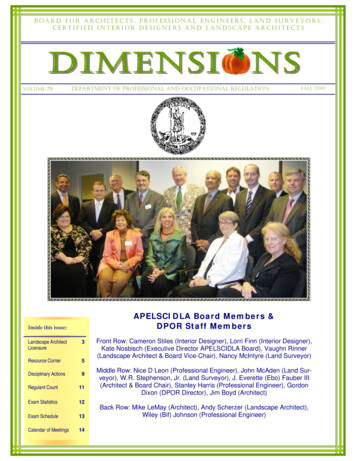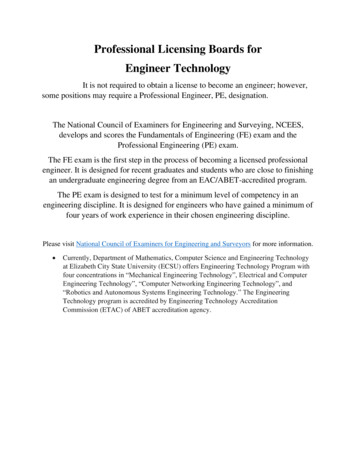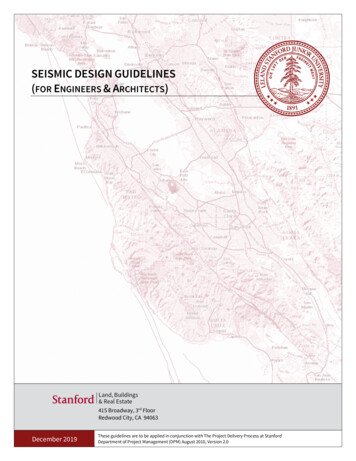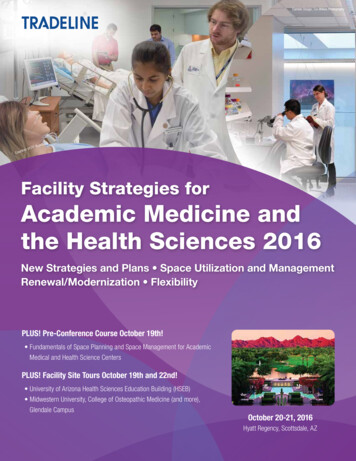
Transcription
BOARD FOR ARCHITECTS, PROFESSIONAL ENGINEERS, LAND SURVEYORS,CERTIFIED INTERIOR DESIGNERS AND LANDSCAPE ARCHITECTSDIMENSIVOLUME 29NSDEPARTMENT OF PROFESSIONAL AND OCCUPATIONAL REGULATIONFALL 2010APELSCIDLA Board Members &DPOR Staff MembersInside this issue:Landscape ArchitectLicensure3Resource Corner5Disciplinary Actions9Regulant Count11Exam Statistics12Exam Schedule13Calendar of Meetings14Front Row: Cameron Stiles (Interior Designer), Lorri Finn (Interior Designer),Kate Nosbisch (Executive Director APELSCIDLA Board), Vaughn Rinner(Landscape Architect & Board Vice-Chair), Nancy McIntyre (Land Surveyor)Middle Row: Nice D Leon (Professional Engineer), John McAden (Land Surveyor), W.R. Stephenson, Jr. (Land Surveyor), J. Everette (Ebo) Fauber III(Architect & Board Chair), Stanley Harris (Professional Engineer), GordonDixon (DPOR Director), Jim Boyd (Architect)Back Row: Mike LeMay (Architect), Andy Scherzer (Landscape Architect),Wiley (Bif) Johnson (Professional Engineer)
Welcome!The APELSCIDLA Board would like to welcomeGordon N. Dixon, the recently appointed Directorof DPOR.Gordon has over 15 years working with regulatory, public policy and community engagementissues affecting various businesses. He has heldnumerous leadership positions in corporate andnon-profit organizations.Most recently, Gordon held a management position in Corporate Affairs at Altria Client Serviceswhere he successfully developed and enhancedcommunity engagement and corporate social responsibility initiatives, as well as assisting to develop measurement benchmarks.Prior to his work at Altria Client Services, Gordonled the Virginia chapter of the National Federationof Independent Business (NFIB) with over 9,000independent business owners. He oversaw publicpolicy and regulatory issues affecting businessowners on the state and federal levels to ensurea fair and prosperous business climate. Other organizations Gordon has worked with include theHome Builders Association and the Greater Richmond Chamber of Commerce, where he helpedlead government, business and manufacturingissues.Gordon, is a graduate of Mary Washington College (now the University of Mary Washington), ismarried to the former Valeta Vander Linden, andhas two boys. He enjoys mountain and road biking.The APELSCIDLA Board would also like towelcome, Justin Garofalo, as a new BoardAdministrator. Justin comes to us from theBoard for Asbestos, Lead, and Home Inspectors and the Board for Waterworks andWastewater Works Operators and OnsiteSewage System Professionals, where he wasBoard Administrator for two years. Prior tothat, Justin worked as a licensing specialistfor the Board of Contractors.Justin is originally from Waldo, Wisconsin;after moving to Virginia he attended VirginiaCommonwealth University where he graduated Magna Cum Laude with a BA in International Studies, with a concentration in International Relations and a minor in Spanish. Mr.Garofalo also served in the 82nd AirborneDivision as a paratrooper and was stationedat Camp Greaves, South Korea.Visit the Town Hall website for up-to-dateinformation on regulatory actions, meetinginformation and much, much more.https://www.townhall.state.va.us/intro.cfm
Understanding theARERolling ClockLANDSCAPE ARCHITECTLICENSURECongratulations to our Landscape Architects! OnMarch 27, 2009, former Governor Tim Kainesigned SB 940, requiring licensure for LandscapeArchitects in the Commonwealth of Virginia. Thelicensure law was effective July 1, 2009, with a12-month delayed enactment clause. This signified that any certified landscape architect in goodstanding on June 30, 2010, was licensed on July1, 2010. Please note that with the change fromcertification to licensure, you will need to have aseal/stamp with “Lic.” to replace the certifiedstamp.The statutory change also means landscape architects must attest to the required 16 hours Continuing Education upon license renewal. TheBoard will use a random audit process to ensurethat licensees are meeting the requirement. Youdo not have to submit CE documentation to theBoard, but need to keep a file of all relevant documentation for CE coursework. If you are selectedfor an audit, you then must produce documentation for CE hours obtained in the preceding twoyears.For further information, refer to 18VAC10-20-683and18VAC10-20-687 of the APELSCIDLA Boardregulations (effective July 1, 2010).The following is an excerpt from the NCARB 20102011 Handbook for Interns and Architects, Chapter 5.Please contact NCARB with any further questions."For applicants who have passed one or more but notall divisions of the ARE by January 1, 2006, such applicants will have five years to pass all remaining divisions. A passing grade for any remaining division shallbe valid for five years, after which time the divisionmust be retaken if the remaining divisions have notbeen passed. The five-year period shall commenceafter January 1, 2006 on the date when the first remaining division is passed. Any division passed priorto January 1, 2006 shall no longer remain valid if allremaining divisions have not been passed by July 1,2014."Key Points: If a division was passed prior to January 1,2006, the candidate's five-year period will begin on thedate when the first passed division was administeredafter January 1, 2006. A passing grade for any division taken after January 1, 2006 will remain valid for five years. This fiveyear period begins on the date the division was taken. If a candidate’s Rolling Clock end date is reached,only the passing score for the division establishing theRolling Clock end date will expire. Once a candidate’s Rolling Clock end date isreached, a new Rolling Clock end date will be established from the date of the next oldest passed division. Any division passed prior to January 1, 2006 willno longer be valid, if a candidate has not passed alldivisions of the ARE by July 1, 2014.If a division becomes invalid, a candidate must contacttheir jurisdiction to have a new eligibility opened in order to retake the division. If you are a Direct Registration candidate, please contact NCARB to have a neweligibility opened. Not sure if you are a Direct Registration candidate? [Ask NCARB]If you have any questions regarding NCARB’s RollingClock, please contact NCARB at are@ncarb.org.
2010 General AssemblyReportLegislative Proposals Affecting theAPELSCIDLA Boardsought a bill, HB 634, proposing a new exemption tothe licensure requirements for PEs for designers ofsuch prepackaged systems. After the House of Delegates approved HB 634, the bill failed to be reportedout of the Senate General Laws Committee. HB 634will not become law this year, but the issue is likely togenerate additional legislation in future sessions.During the 2010 General Assembly Session, DPOR’slegislative team tracked more than 65 bills affecting avariety of agency programs. Brief descriptions of legislation affecting the APELSCIDLA Board and its regulants are provided below.To view the full text of the bills and their current status,visit the Virginia Legislative Information System athttp://leg1.state.va.us and search by bill number.SB 596 is a bill brought by DPOR to establish an“emeritus” status for retired architects, professionalengineers, land surveyors, and landscape architects.Because of the unique statutory provisions allowingsuch licenses to be “valid during the life of the holder,”the APELSCIDLA Board voted to request legislation toclarify the use of title-protected designations by retired,non-practicing license holders. “Emeritus” status willallow the use of the license designation without meeting continuing education and license renewal requirements.Did You Know . . . If your company offers professional services inVirginia through a website, it must be maintainedwith up-to-date, accurate information. Additionally,if you advertise multiple professional services onthe website (i.e., engineering and land surveying),you must ensure that the firm is properlyregistered with the Board to offer those services.Further, if the company offers multiple services inanother state, but only one in Virginia (forexample, an architectural and engineering firmbased in Maryland that only offers/providesprofessional engineering in Virginia), the websitemust clearly notate which professional service(s)the company is authorized to offer and/or providein Virginia. Using the previous example, the firmmust not have any appearance of offering orproviding architectural services in Virginia if theyare only authorized to offer/provide professionalengineering services in Virginia. Changes to the professions rendered through yourcompany or changes in individuals in responsiblecharge can easily be made using the appropriatebusiness application and checking the spacenotated “Change of Status.” There is no chargefor processing this form; however, the Board mustbe notified of the change within 30 days. The formmay be accessed on the Department’s website 4busreg.pdf.HB 1265 is a bill brought by DPOR to add CertifiedInterior Designers to the list of APELSCIDLA Boardregulants in the State Corporation Commission (SCC)statute governing professional corporations (PCs). Thebill corrects an oversight from 2000 in which the legislature inadvertently omitted Certified Interior Designersfrom the board of director section for PCs.HB 797 and SB 104 are companion bills brought bythe joint legislative committee of the Virginia Society ofProfessional Engineers (VSPE), the Virginia Society ofthe American Institute of Architects (VSAIA) and theVirginia chapter of the American Council of Engineering Companies (ACEC/VA). The bills will allow APELSCIDLA Board regulants – individuals and firms – tolimit their liability through contract provisions. Currentlaw allows APELSCIDLA Board regulants to form corporate entities, but prevents such entities from limitingthe liability of individual regulants and registered firmsfor damages.Finally, one bill resulted from an ongoing dispute concerning design of certain alternative onsite sewagesystems. Despite DPOR’s efforts during 2009 to facilitate agreement between the PE community andthe manufacturers of prepackaged pump systems, theaffected stakeholders failed to achieve consensus onan acceptable solution. As a result, a manufacturer
Compliance &InvestigationsDivisionThe Compliance & Investigations Division of the Department of Professional and Occupational Regulation("the Department") is divided into the following sections:Complaint Analysis and ResolutionThe Complaint Analysis and Resolution section is responsible for the receipt, processing, and analysis ofall complaints coming into the Department. Upon review, the Complaint Analysis and Resolution Sectionmay close the file, investigate the complaint, resolvethe matter by a consent order, or refer the case to Alternative Dispute Resolution or Investigations for further action.InvestigationsInvestigators are responsible for obtaining the evidence regarding complaints and determining whetherthe evidence supports a probable violation of theBoard's regulations and/or laws. Investigators preparea Report of Findings, which outlines the facts in support of probable violation(s) of the Board's regulationsand/or laws.Investigators also enforce the criminal laws under theAgency's jurisdiction, including practicing without alicense and filing a false or fraudulent application forlicensure or registration.Investigators are also responsible for other specialinvestigations involving potential public harm and arethe Agency's liaison and networking arm providing assistance and support to other law enforcement andgovernment agencies.This section is active in the identification and apprehension of itinerant home improvement scam artistsand provides information to the public on protectionfrom fraudulent or illegal activity. For more information,contact the Department of Professional and Occupational Regulation, (804)367-2195.AdjudicationThe Adjudication section reviews files referred fromComplaint Analysis and Resolution or Field Investigations that there is probable cause of a violation of theBoard's regulations and/or laws. The Adjudication section is responsible for conducting Informal Fact-FindingConferences ("IFF"), which includes scheduling theIFF, sending the Notice, presenting the IFF, and providing support to the Presiding Officer or Board member at the IFF in preparing the Summary.Branch OfficeRegistrationThe Board would like to reiterate the importanceof having your business entity properly registered,especially branch offices. A company that hasmore than one office offering or performing professional services in Virginia must obtain abranch office registration for each additional office.Registrations for professional corporations,PLLCs and business entities expire on December31 of each odd-number year. Branch office registrations expire the last day of February of eacheven-numbered year. Branch offices may notrenew until the main office registration is properlyrenewed. Although renewal notices are mailedout, it is the regulant’s responsibility to ensurethat the firm holds a current registration.Resource CornerNational Council ofExaminers for Engineering andSurveyingwww.ncees.orgNational Council ofArchitectural RegistrationBoardswww.ncarb.orgNational Council of InteriorDesigners Qualificationwww.ncidq.orgCouncil of LandscapeArchitects Registration Boardswww.clarb.orgFollow theseOrganizations onFacebook andTwitter
NCIDQ Begins Five-YearRequirement forExam CompletionThe National Council for Interior Design Qualification,Inc. (NCIDQ) has announced a policy effective in 2010that requires candidates taking the NCIDQ Examination toearn the NCIDQ Certificate to pass all sections of the examination within a five-year period or retest.This five-year “rolling” window of time describes the wayin which the timing accrues. Rather than one five-yearfixed period of time, a candidate’s time “rolls” forward infive-year increments depending on when he or she passesan exam section.The practice of interior design evolves, and it is criticalthat individuals who hold the NCIDQ credential have beentested on the practice as it is relevant today. “Most majorlicensure or certification programs that deal with publicprotection have similar requirements,” explains Jeffrey F.Kenney, NCIDQ Executive Director. “Certification andlicensure examinations represent to the public that the individuals who hold their credential have been determined tobe at least minimally competent at the time the credentialwas issued. When candidates are allowed to take individualtest sections over many years or decades, it is harder toclaim that at one point in time these individuals possessedall of the knowledge, skills and abilities required for minimum entry-level competence.”Candidates who have taken at least one section of theexamCandidates who have taken at least one section of theNCIDQ Examination must pass all three sections by December 31, 2014. After that date, NCIDQ will void anysections passed more than five years earlier, and candidatesmust retake those sections and complete the exam within anew five-year window.Candidates who will begin testing in 2010Candidates who begin testing for the first time starting in2010 must complete all sections of the exam within a fiveyear window. After five years, NCIDQ will void any sections passed more than five years earlier and the candidatemust retake those sections and complete the exam within anew five-year window.“There will be very few people affected by these changes,”says Kenney. “We know most of our candidates begin testing and earn their credential within the first year or two oftheir eligibility. However, we remain committed to ourmission of public protection, and so for that small part ofour candidate population that doesn’t pass the exam in fiveyears, we will now mandate the five-year requirement.”Candidates who do not take any sections of the examination within five years of being made eligible by NCIDQwill lose their eligibility status. Candidates who lose theireligibility status due to non-testing must reapply, meet therequirements in effect at that time and pay any applicationfees.Please visit NCIDQ’s Web site for complete informationand instructions on applying for the examination.Reprinted from NCIDQ news Release October 2009NCARB's2010 Survey ofRegisteredArchitectsThe 2010 survey of state architectural registrationboards by the National Council of Architectural Registration Boards (NCARB) indicates that there are currently 105,312 registered architects in the UnitedStates. Data was collected in August 2010 and reflectsJuly 2009 through July 2010.The 2010 survey also reveals that there are 116,340reciprocal (out-of state) architects, for a total of221,652 registrations. This means, on average, an architect is registered in at least two different jurisdictions. California has the highest number of residentarchitects (17,156) and the highest number of totalregistrations (21,276).NCARB collects data for the survey from its 54 Member Boards, which includes all 50 states, the District ofColumbia, Guam, Puerto Rico, and the U.S. VirginIslands. NCARB makes this information availableannually as a service to the profession. For more information about the 2010 Survey of Registered Architects, contact NCARB at 202/783-6500.(www.ncarb.org)
Six Month Rule—Are you Ready?The Six-Month Rule went into effect for all interns at12:01 a.m. EDT on 1 July 2010. The Six-Month Rulewas already in effect for interns that established anNCARB Record on or after 1 July 2009.If you established your Record prior to 30 June 2009,you must submit all previous experience earned priorto 12:01 a.m. EDT on 1 July 2010. Experience reported on or after 1 July 2010 that falls outside of therequirements of the Six-Month Rule will not be accepted if it has not been submitted to your supervisor.Your supervisor does not need to approve it by thisdate.The Six-Month Rule requires interns to submit theirtraining hours in reporting periods of no longer than sixmonths and within two months of completion of eachreporting period. Once interns have submitted theirtraining hours to their supervisor through the electronicExperience Verification Reporting (e-EVR) system inMy NCARB Record, those hours are protected whileunder review. To be protected, you must have a"submitted" status on the upper right of the report. Areport that has a "saved" status is not protected.Interns will not be affected by any delay caused bytheir supervisor or NCARB. However, submitted training hours can be lost if they are deemed invalid bytheir supervisor, or if they are not earned in accordance with the rules of the IDP.Extensions are available for the birth or adoption of achild, military service, or serious medical condition. Anextension form with supporting documentation must besubmitted to NCARB. Extensions apply only to the experience-filing period. There are no exceptions or extensions granted for missing the deadline to establishan NCARBThe Six-Month Rule is designed to encourage bettersupervision, encourage interns to target the neededexperience sooner, and encourage better reportinghabits. Six months is the maximum amount of time inwhich to report. NCARB encourages interns to reportmore frequently.IDP 2.0: Phase Three Set for January 2011The third phase of IDP 2.0 will go into effect in January2011 and will usher in changes to the Intern Development Program (IDP) work settings and experience areas. While the overall experience requirement will remainthe same in terms of actual work hours (5,600), the distribution of the core minimums will be slightly different.For those in the midst of completing the program, previously entered training hours will be automatically reassigned to the appropriate area, and no experience willbe lost.The new experience areas are based on the results ofthe 2007 Practice Analysis of Architecture. As the mostin depth study of its kind, the Practice Analysis providedup-to-date, empirically derived data that defines thecomprehensive experience essential for competentpractice of architecture upon initial licensure. The studyidentified 88 tasks and 100 knowledge/skills that areimportant for competent performance by recently licensed architects practicing independently. Each of theIDP 2.0 experience areas will be defined by the tasks anintern should be able to perform upon completion oftheir internship.The development of IDP 2.0 also presented an opportunity to clarify and simplify the acceptable settings forearning IDP credit. The current seven work settings willbe combined into three acceptable experience settingsin IDP 2.0. They are: A: Architectural Practice O: Other Work Settings S: Supplemental ExperienceExperience earned under the direct supervision of anarchitect while working at an architecture firm (work setting A) will be considered experience area "A: Architectural Practice." Experience earned under the direct supervision of a licensed engineer, currently (work settingD) will continue to be acceptable experience under "O:Other Work Settings." All experience earned in the current work settings will be moved to their related experience setting in IDP 2.0. No experience will be lost.For more information on the third phase of IDP 2.0, readthe Spring 2010 Direct Connection, which includes theall the new experience areas and how they compare tothe current areas.(Reprinted from: NCARB IDP E-News,March 2010)
FE, FS Exams to Begin Gradual Move toComputer-Based FormatThe state licensing boards that compose NCEES, the organization that develops and administers the exams used for engineering and surveying licensure throughout the United States,have voted to begin converting the Fundamentals of Engineering (FE) and Fundamentals of Surveying (FS) exams to a computer-based format.The decision was made during the NCEES Annual Meeting inDenver. It followed a prolonged study by a special task forceconvened to consider the issue and share its findings with theorganization.Transition expected to take at least two yearsThe move from paper-and-pencil exams to computer-basedexam delivery will not take place overnight, said NCEES Executive Director Jerry Carter."The language approved by the Council includes the phrase ‘atthe earliest feasible date,' which means that NCEES examwriters and staff will be involved in a process that includesadapting exam item banks, selecting vendors, and communicating with licensing boards and examinees before we canbegin offering the exams via computer," said Carter."We anticipate it will be at least two years before FE and FScandidates begin taking the exams at computer-testing centers."Flexibility and security key factors in decisionAmong the reasons given by the NCEES Computer-BasedTesting Task Force for its recommendation to convert the exams to a computer-based format include greater schedulingflexibility for candidates, more uniformity in testing conditions, and enhanced security for exam content. The vote tomove toward computer-based testing for the FE and FS examswas unanimous.The FE exam is designed for college engineering seniors whointend to pursue a P.E. license. Nearly 50,000 examinees tookthe FE exam during the 2009-10 academic year, which included October and April administrations. The FS exam is asimilar exam designed for those beginning the process towardprofessional surveying licensure.The PE and PS exams, which engineering and surveying candidates are also required to take after completing work experience requirements, will continue to be paper-and-pencil examsfor the foreseeable future.Full details on this vote and other actions taken at the NCEESAnnual Meeting can be found in the published minutes, whichwill be available in November on the My NCEES webpage.(Reprinted from NCEES News Release August 2010)ANSI Recognizes Model LawSurveyor StandardThe American National Standards Institute approved theModel Law Surveyor (MLS) standard developed by NCEES.This standard outlines the requirements for attaining licensureas a professional surveyor. Its criteria are divided into education, professional experience, and examinations. The standardis used by NCEES as a guideline for its member licensingboards, which grant licensure to engineers and surveyors in all50 states and several U.S. territories.Prior to being approved by the ANSI Board of Standards Review, the MLS standard was published on the NCEES homepage and in ANSI's Standards Review and open to publiccomment."We're looking forward to promoting this standard to encourage uniform licensing standards and, ultimately, better protectthe public," said Jerry Carter, NCEES executive director.NCEES has been a standards development organization ofANSI, the U.S. representative to the International Organization for Standardization (ISO), since 2007. Its standard forModel Law Engineer was approved by ANSI earlier this year.Its standard for Model Law Structural Engineer is currentlyunder public review.NCEES Unveils NewAgricultural PE ExamSpecificationsNCEES has introduced new specifications for its AgriculturalPE exam, effective with the October 2010 exam administration.Exam specifications indicate knowledge areas to be tested andtheir relative weights of emphasis. As the developer of theexams used for engineering licensure in the United States,NCEES periodically conducts surveys of licensed engineersworking in industry, government, private practice, and academia to gather information about the knowledge and skills required of professionals in a particular discipline. NCEES usesthe results to update its exam specifications."Our licensing exams need to reflect current professional practice, and these surveys help us determine what an engineerintern with four years of experience should be expected toknow to protect the public," said Tim Miller, P.E, the directorof exam services at NCEES.The new specifications are available on the NCEES website.The American Society of Agricultural and Biological Engineers, which partners with NCEES in developing the exam,has exam study materials on their website:www.asabe.org.(Reprinted from NCEES News Release October 2009)
Disciplinary ActionsThe following is a summary of actionstaken against regulants by the APELSCIDLA Board. Although every effortis made to ensure that the informationis correct, before making any specificdecisions based upon this information,you should check with the Board office to ensureaccuracy.PROFESSIONAL ENGINEERSFILE NUMBER 2009-04078, Walter J. FitzgeraldVIOLATION—Mr. Fitzgerald failed to notify the Boardwithin 30 days that he had been reprimanded by theFlorida Board of Professional Engineers.BOARD ACTION—Consent Order imposing 150.00in Board costs and 18 months of probation of licenseREGULATIONS VIOLATED—18 VAC10-20-750.Aand 18VAC10-20-750.C EFFECTIVE DATE—September 15, 2009.FILE NUMBER 2009-03763, W. Gray HodgeVIOLATION—Mr. Hodge was reprimanded by theFlorida Board of Professional Engineers by “engagingin negligence in the practice of engineering.” BOARDACTION—Consent Order imposing 150 in boardcosts as well as probation of license to coincide withthe Florida Board agreement. Mr. Hodge must alsoprovide proof of compliance of the Florida ECTIVE DATE—September 15, 2009.FILE NUMBER 2009-04076, Thomas R. PriceVIOLATION—Mr. Price failed to notify the Boardwithin 30 days that he received a reprimand and amonetary penalty in another jurisdiction. BOARDACTION—Consent Order imposing 250 in fines aswell as 150 in Board costs. REGULATIONS VIOLATED—18VAC10-20-750.B and 18VAC10-20-750.CEFFECTIVE DATE—September 15, 2009.FILE NUMBER 2009-01623, George Charles StephensonVIOLATION—Mr. Stephenson signed and sealeddrawings that were within the practice of architectureand submitted designs from his own company to thecity for which he was a city official (Conflict of Interest).BOARD ACTION—Consent Order imposing 5000 infines, as well as 150 in board costs, 6 month suspension of license, probation for 2 years. Mr. Stephensonmust also complete 3 hours of coursework in 10-20-710.B; and 18VAC10-20-760.B.EFFECTIVE DATE—September 15, 2009.FILE NUMBER 2010-01540, David Eugene McFarrenVIOLATION—Mr. McFarren was reprimanded by theAlabama Board of Licensure for Professional Engineers and Land Surveyors for failing to obtain acertificate of authorization for his firm. Mr. McFarrenfailed to notify the Board within 30 days that he hadbeen reprimanded by the Alabama Board.BOARD ACTION—Consent Order imposing 150 infines and 150.00 in Board costs and 1 year probationof license. REGULATIONS VIOLATED—18 VAC1020-750.B EFFECTIVE DATE—March 23, 2010.FILE NUMBER 2010-01680, George E. Young IIIVIOLATION—Mr. Young utilized design/drawings ofanother engineer to complete his own design/drawingsor work related to the revisions of site plans withoutthe knowledge and written consent of the otherengineer.BOARD ACTION—Consent Order imposing 350.00in fines as well as 150 in Board costs REGULATIONVIOLATED—18VAC10-20-740.DEFFECTIVE DATE—June 17, 2010.FILE NUMBER 2010-03739, Stephen Phillip MaslanVIOLATION—Mr. Maslan was reprimanded by theMissouri Board for practicing architecture that was notincidental to the engineering work. Mr. Maslan failedto notify the Board within 30 days that he receiveddisciplinary action and probation in another state.BOARD ACTION—Consent Order imposing 200.00and 150 in Board costs, as well as probation to runconcurrently with Missouri. REGULATIONS VIOLATED—18VAC10-20-750.A and 18VAC10-20-750.CEFFECTIVE DATE—June 17, 2010.FILE NUMBER 2009-04265, Francis J. KeithVIOLATION—Mr. Keith’s engineering firm developedplans for a commercial building, Fountain SquarePlaza, in Chester, VA. There was an incident duringconstruction where a portion of the building collapse
CERTIFIED INTERIOR DESIGNERS AND LANDSCAPE ARCHITECTS DIMENSI NS DEPARTMENT OF PROFESSIONAL AND OCCUPATIONAL REGULATION VOLUME 29 FALL 2010 Landscape Architect . (Interior Designer), Lorri Finn (Interior Designer), Kate Nosbisch (Executive Director APELSCIDLA Board), Vaughn Rinner (Landscape Architect & Board Vice-Chair), Nancy McIntyre (Land .











